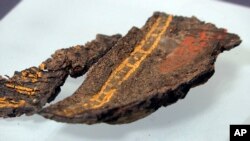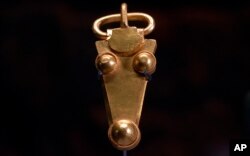Archaeologists say an underground chamber discovered accidentally by road workers may be the site of the earliest Christian royal burial in Britain.
The chamber was uncovered between a road and a railway line in the village of Prittlewell in 2003. It turned out to be a 1,400-year-old burial site containing items that were interred with whoever was buried there.
The contents included a golden belt buckle, remnants of a harp, glassware and an elaborate water vessel.
New details of archaeological findings were announced Thursday.
Researchers say the luxury burial items indicate the chamber's occupant was of high standing, possibly a prince. Two gold-foil crosses at the head of the coffin suggest a Christian burial.
Sophie Jackson, director of research and engagement at Museum of London Archaeology, called the discovery "our equivalent of Tutankhamun's tomb."





